The Samsung Galaxy S9 and S9+ Review: Exynos and Snapdragon at 960fps
by Andrei Frumusanu on March 26, 2018 10:00 AM ESTThe Snapdragon 845 - A Quick Recap
Starting with Qualcomm's Snapdragon 845 – we already extensively covered during the December launch announcement as well as Qualcomm’s traditional performance preview most recently in February.
| Qualcomm Snapdragon 845 vs 835 | |||
| SoC | Snapdragon 845 | Snapdragon 835 | |
| CPU | 4x Kryo 385 Gold (A75 derivative) @ 2.8GHz 4x256KB L2 4x Kryo 385 Silver (A55 derivative) @ 1.77GHz 4x128KB L2 2MB L3 @ 1478MHz |
4x Kryo 280 Gold (A73 derivative) @ 2.45GHz 2MB L2 4x Kryo 280 Silver (A53 derivative) @ 1.90GHz 1MB L2 |
|
| GPU | Adreno 630 @ 710MHz | Adreno 540 @ 670/710MHz | |
| Memory | 4x 16-bit CH @ 1866MHz LPDDR4x 29.9GB/s 3MB system cache |
4x 16-bit CH @ 1866MHz LPDDR4x 29.9GB/s |
|
| ISP/Camera | Dual 14-bit Spectra 280 ISP 1x 32MP or 2x 16MP |
Dual 14-bit Spectra 180 ISP 1x 32MP or 2x 16MP |
|
| Encode/ Decode |
2160p60 10-bit H.265 720p480 |
2160p30 (2160p60 decode), 1080p120 H.264 & H.265 |
|
| Integrated Modem | Snapdragon X20 LTE (Category 18/13) DL = 1200Mbps 5x20MHz CA, 256-QAM UL = 150Mbps 2x20MHz CA, 64-QAM |
Snapdragon X16 LTE (Category 16/13) DL = 1000Mbps 3x20MHz CA, 256-QAM UL = 150Mbps 2x20MHz CA, 64-QAM |
|
| Mfc. Process | 10nm LPP | 10nm LPE | |
The Snapdragon 845 is the first SoC to adopt ARM’s new DynamIQ CPU topology and cores. The new configuration includes a larger coherent cluster instead of separate clusters for the little and big cores. While this new configuration allows for better performance and core configuration scaling, Qualcomm opted to continue the traditional 4+4 CPU set that we’ve seen with the Snapdragon 835. The performance core comprise of the Kryo 385 Gold cores which are derivative of ARM’s Cortex-A75’s and are running at up to 2803MHz. The efficiency cores are the Kryo 385 Silver cores which are based on ARM Cortex-A55’s and are running at up to 1766MHz.
Among the big improvements of the Snapdragon 845 includes the introduction of the new X20 modem which supports LTE UE Category up to 18 in the downstream and Category 13 in the upstream.
The Snapdragon 845 is also the first SoC from Qualcomm to adopt the new in-house designed Adreno 630 which marks a generational leap in the graphics department. I can confirm that Qualcomm continues the trend of trying to maintain clock frequencies between generations and the Adreno 630 in the Galaxy S9 comes in at 710MHz – a bump from the 670MHz in the Galaxy S8 but the same as other Snapdragon 835 devices. We’ll be having a more in-depth evaluation of the new Adreno in the GPU part of the review later on.
Unique for Android SoCs is also the first time introduction of a new system wide “L4” cache 3MB in size which is meant to reduce system memory access not only from the CPUs but also every other IP block in the SoC, thus gaining power efficiency.

Snapdragon 845 Floor Plan. Image Credit TechInsights
Our friends at TechInsights this week were able to publish a die shot of the Snapdragon 845, and it’s interesting to see the changes compared to the Snapdragon 835. Because the Snapdragon 845 is manufactured on Samsung’s 10LPP process, there aren’t any new density improvements over last year’s 10LPE Snapdragon 835. Naturally because the new SoC includes new IP and improvements, die size has increased from 72.3mm² to around 94mm².
The biggest contributor of this increase will be the new system cache, which is part of the area that TechInsights (erroneously in my belief) marked as the DSP. Here we four new blocks to what I think are simply four banks of SRAM and their arbitration logic and their responsibility is divided among the four memory controller channels.
On the CPU side we see the new DSU lying in-between the A55 cores with the A75 cores spread around the little cores and the DSU. The 2MB L3 cache a big unified block alongside the DSU and little cores. Based on TechInsights preliminary low-res picture, the CPU complex comes in at 11.39mm² with an A75+L2 core coming in at 1.57mm² and the A55+L2 coming in at ~0.53mm².
The Adreno 630 seems to have consolidated a lot of its inner components. We still see a clear 4-shader core arrangement, however instead of having one adjacent block next each shader core we now see a larger block shared among two shader cores. The shader cores are also vastly improved as they have doubled the ALU pipelines. On the die shot it looks like the GPU actually only has 2 separate units, and this is confirmed by the drivers of the Snapdragon 845: instead of a quad-core Adreno 540, the Adreno 630 is a dual-core GPU. The texture units/ROPs/GMEM blocks have also been consolidated from four units down to two larger blocks, with a 50% increase in texture throughput. Overall there’s been extensive rework throughout the GPU resulting in a “simplified” configuration that seems to be forward-looking in terms of future scalability. Qualcomm has also achieved this in a mere ~10.69mm², making the Adreno 630 the by far smallest high-end GPU in the mobile space by a significant margin.
In terms of CPU performance, the new Kryo 385 Gold cores shouldn’t veer off much from ARM’s Cortex A75 microarchitecture. We’ve extensively covered the improvements in last year’s Tech Day reveal article. Overall the Cortex A75 is a strong successor to the A73 but refines the microarchitecture in terms of memory performance and especially floating point performance.
Following the performance preview of the Snapdragon 845 in February I noted that I was a bit disappointed in the end-performance of the CPUs as they did not reach ARM’s quoted performance targets. I want to revisit this a bit attempt to try to explain the different factors that lead to it.
Firstly ARM’s performance figures were projected on a configuration of A75 coupled with 512KB L2 caches. Qualcomm opted to use 256KB caches which may account for a few percentages in performance.
The new memory subsystem of the Snapdragon 845 also isn’t without faults: the initial increased DRAM memory latency that we measured on Qualcomm’s QRD845 reference platform is definitely carrying over to retail consumer devices, as the Galaxy S9 exhibits the same behaviour. This is quite a disappointing characteristic to find as it will counteract a lot of performance gains – especially in memory latency sensitive workloads – which we’ll confirm later on in the SPEC benchmarking portion.
Finally, one big question that Qualcomm teased about in its announcement event, is the configuration of the DSU. Qualcomm explained that the CPU complex was powered by three voltage planes – and I can confirm that my initial assessment was correct as two frequency and voltage planes power the little and big cores, and the third voltage plane powers the DSU/L3 and the cDSP (On of the various DSPs). The frequency here tops out at 1478MHz which is a tad lower than I had expected.
When reading ARM’s TRM (Technican Reference Manual) of the DSU, we see one particular claim regarding the recommended clocks of the L3 in relation to the CPU clocks:
"SCLK frequency affects the L3 hit latency and, therefore, it is important for achieving good performance. For best performance, ARM recommends running SCLK as close to CORECLK[CN:0] frequency as possible. However to reduce dynamic and leakage power, targeting a lower frequency might be required. Running SCLK at least approximately 75% of the CORECLK[CN:0] frequency might give an appropriate balance for many systems."
The Snapdragon’s big cores run at up to 2803MHz so running the L3 at up to only 1478MHz represents only 52% of the peak frequency. We’re not able to judge what kind of performance impact Qualcomm’s configuration has, but it looks like there will be some sort of degradation compared to an optimally run system.
All in all – the reduced 256KB cache, DRAM memory latency degradation as well as the more conservative maximum frequency of the L3 all can add up and may explain why the Snapdragon 845 wasn’t able to quite reach ARM’s projections on performance of the new core.
In general the Snapdragon 845 looks like a great SoC on paper – there should be good CPU improvements as well as excellent GPU leaps, but that’s no news given that we knew that from the performance preview. The only remaining question is power efficiency, which we’ll be looking at shortly after we cover the competition’s SoC.


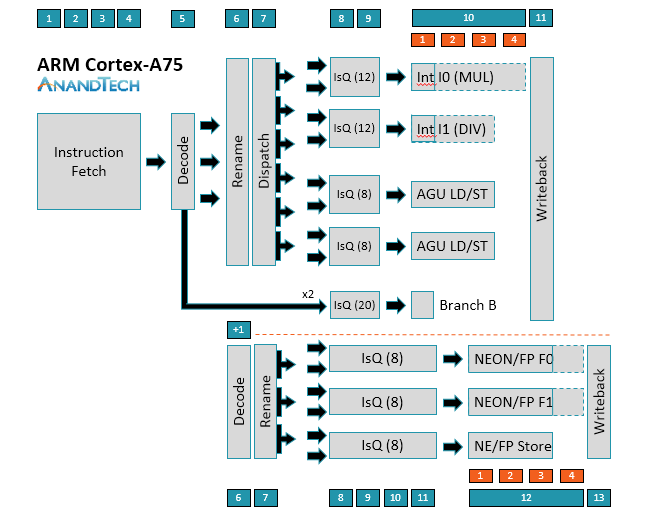
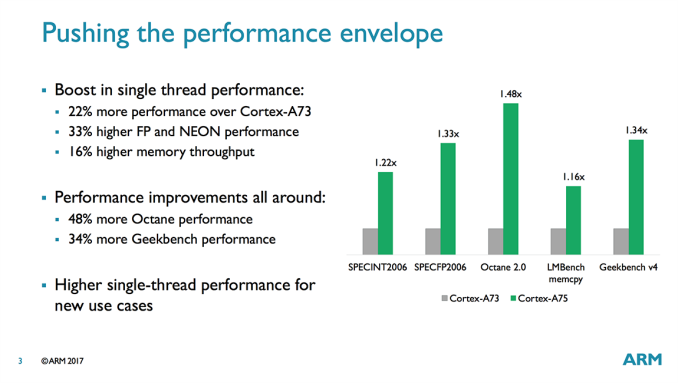
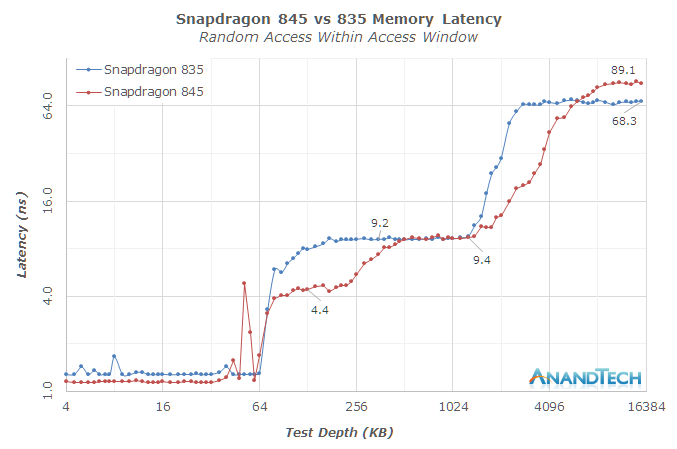
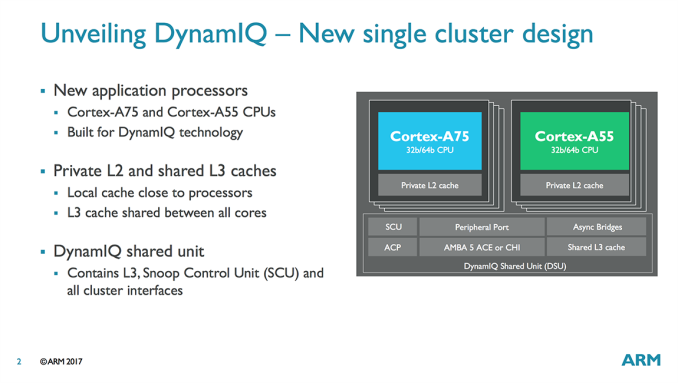
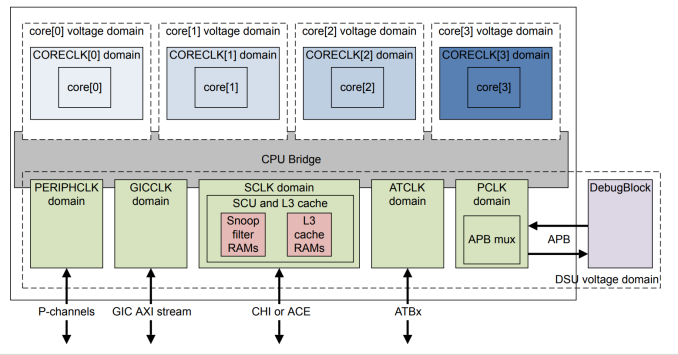








190 Comments
View All Comments
lopri - Monday, March 26, 2018 - link
Oh and there is no Fraps on Android or (gasp) iOS as far as I know. One that actually works.jjj - Tuesday, March 27, 2018 - link
Anything is better than synthetic.What happens in this review is a great example because judgements are made about how perf and power are balanced, without any testing in appropriate workloads. The SoC needs to be tuned for actual workloads, and aside from anecdotal evidence, there is no data. AT loves to say that it's data driven but if you don't have the relevant data.... You can't determine the color of the sky by licking a wall.
Synthetic benchmarks are a best effort from a developer but they can never match real world apps. PCMark for example, some phones with 8xA53 at 2GHz can score over 5k points so almost as much as the Exynos here.
It's been 10 years and nobody makes any effort to review phones. Even battery life, it's either synthetic or browsing with nothing else going on, utterly unrealistic.
ZolaIII - Tuesday, March 27, 2018 - link
You can profile individual apps & use them while doing so but the results will vary to much even if your usage is minor like for instance video player & same video. Simply Android platformom has to much back processes and noise for reliable measuring especially if those are lite tasks.techconc - Tuesday, April 17, 2018 - link
Do you understand the sub tests in something like Geekbench for example? Are you going to claim that they are not representative of real world functions that your phone uses on a regular basis? Screaming no synthetic benchmarks like a lunatic without offering a better and generally accepted alternative is not helpful.peevee - Friday, April 6, 2018 - link
Firefox. With an adblocker installed.name99 - Tuesday, March 27, 2018 - link
Oh FFS.Different benchmarks test DIFFERENT THINGS. What you call a synthetic benchmark is a great test of very specific parts of the CPU or memory system.
If you don't care about details, don't freaking look at the synthetic benchmarks and go straight to whatever whole system benchmark it is that floats your boat.
But don't throw a hissy fit because the guys who ARE interested in **CPU** performance don't want to see numbers that are fscked up by the OS behavior, the performance of the flash, or whatever other random nonsense gets it to confuse the issue.
lilmoe - Wednesday, March 28, 2018 - link
Of course, synthetics at constant max load have never reflected real world performance of mobile devices. We know this. What I like about these deep dives is the fact that you can evaluate the data yourself and make educated assumptions about what one might expect. Here's a rough summary of what I believe is applicable to both chips in the S9 with the current firmware:- Exynos is the faster chip. But it's handicapped for feature and performance parity with the SD. Optimizations in Oreo might have contributed to how such a conservative scheduler passed QC.
- Snapdragon will be snappier (no pun intended) in certain workloads and general app load times.
- Exynos will last longer in games, video playback and streaming.
- Snapdragon might last longer in web browsing.
- Snapdragon Will last longer in video and voice calls in unoptimized messaging apps.
These are examples I thought of quickly. It's funny, but I also watch some youtubers doing their "tests". Combine these tests with the data presented here and there you go.
eastcoast_pete - Monday, March 26, 2018 - link
For me, the winner is - the one that didn't compete here: the S8+ (with the 835 chipset). Seriously. With the S9/9+ now out, an S8 or S8+ can be had for hundreds of $ less than the corresponding S9 or S9+ , and that makes the S8 or S8+ right now the best value for money among higher-end Sammys. To boot, nobody will notice it's last year's model, as the S8 and S9 look almost identical. IMO, the main upside for an S9+ is the camera, especially the video capabilities, but, at what a price -ouch!Processors: Progress - What progress? The 845 did a bit better than the 835, mostly by being clocked higher (and eating a bit more power), while the new M3-based Exynos was really disappointing. I am also disappointed with Qualcomm's 845, and here is why: the 845 is manufactured in the (supposedly) more energy efficient 10 nm LPP (Samsung's newest and hottest), so - where are the power savings? I can't help but wonder how an 835 manufactured in 10 nm LPP would have fared? As is, the 835 mostly holds it's own where it counts (real life situations), and is far from being outclassed by the 845 (or the M3 Exynos, but that is kicking a chip when it's down).
Lastly, regarding Andrei's comment on Samsung's software: right on. Samsung has pretty consistently made the best or among the best Android smartphones out there - I have owned a few of them. But, while Samsung's hardware generally get's a A or A- , the software that Samsung loads (burdens) their phones with has ranged between annoying to debilitating; apparently, that carelessness on the software side extends all the way down to low-level programming this time - not good.
Several years ago and for a short time, one could buy a Samsung phone with stock Android from Google directly. While I realize that won't happen again any time soon, I would love to see an S8+ (835) with just plain-vanilla Android 8.1 (or 9?), no skin, no bloatware. I might even buy one, before they're gone.
BigDH01 - Monday, March 26, 2018 - link
The perf/W graph is confusing to me as it's measured in fps/W. This breaks down into (frames/sec)/(J/s). Why not just frames/joule?Andrei Frumusanu - Monday, March 26, 2018 - link
Because Watts are important to note as a thermal indicator. It gives more information than frames/J.